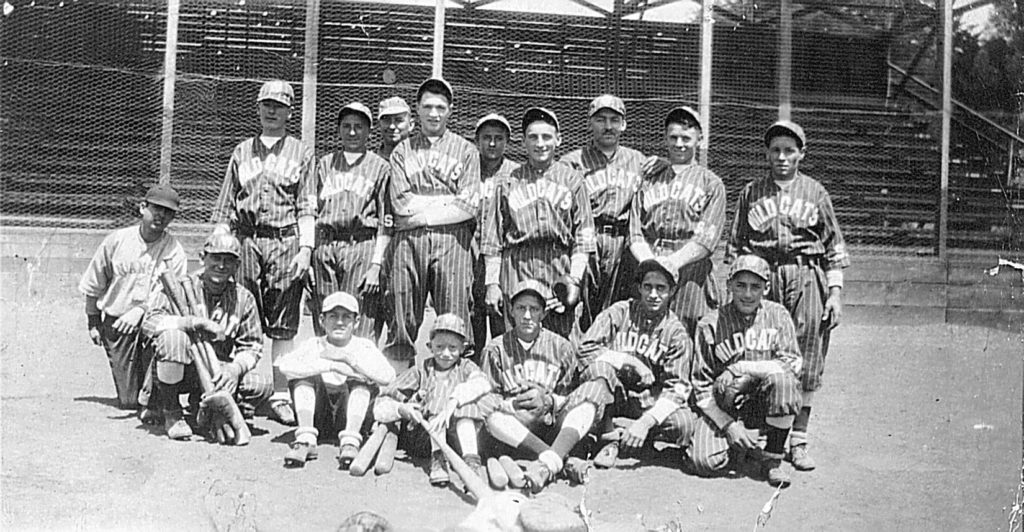
San Anselmo Wildcats, 1927.
Baseball, America’s favorite pastime, was first played in California in 1860, and the umpire’s call of “Play ball!” could be heard on dusty fields in Marin County in 1870. The Marin Journal reported on the organization of a “base ball club” (spelled with two words until the early 20th century) in San Rafael in October 1869, and the men of Tomales organized a club in June 1870. During the 1870s, the Journal mentioned the organization of other clubs, including the Rising Stars, Alerts, Marins, Mutuals, and the Growlers and Snarlers whose game in January 1874 resulted in a 63 to 51 win by the Snarlers. The Alerts and Marins of San Rafael adopted two rules when the clubs were formed: no member was allowed to drink liquor while playing, and swearing was to be punished with a fine. The Fourth of July celebration in 1874 in Nicasio featured the Tomales Club, the Daisy Cutters, against the Marin Base Ball Club.
Fairfax Park, developed by the North Coast Pacific Railroad in 1875, had picnic tables and a dance pavilion as well as a “natural valley base ball ground, which hand of art could not improve.” Early games were played in San Rafael on a field below the B Street railroad station.
By the 1880s, most Marin communities had teams – the Sausalitos, the El Montes, the Novatos, the Nicasios, and Ross Valleys among others – and rivalries were fierce yet friendly with the players often going to lunch or dinner together after the game with the losing team paying. The loser of a June 1881 game in San Rafael was to pay by wheeling “a keg of beer through the streets, selling it at a bit a glass, and turning the proceeds over to the treasury of the San Rafael Base Ball Club.” The treasury of the San Rafaels must have swelled as the team sported new uniforms soon after, ones with blue trousers and shirts trimmed in white braid, blue caps with a white band, and red stockings.
In August 1887, the Coleman Base Ball Club was organized under the management of James I. Taylor, the eldest son of Samuel P. Taylor. The uniform shirts of the Coleman’s were emblazoned with the William T. Coleman & Company’s logo. Jim Taylor and his brother Frank played on the team. The Coleman’s second nine was called the Taylors, and the two teams played popular Sunday afternoon practice games as well as games against other clubs. In October, they played for the first time “under the new rules, and they did not appear to be so popular with the players.” The new rules of baseball introduced that year gave the batter four strikes instead of three [for that year only] and five called balls instead of six became a base on balls.
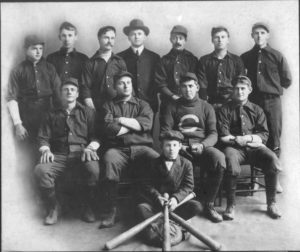
San Rafael Base Ball Club, 1905
The men played with little equipment in the early days. Bats were heavier and had thicker handles than today, and gloves were not common until the late 1880s, and then they resembled leather work gloves. San Rafael Bazaar on Fourth Street advertised in 1890 “the celebrated wagon tongue bats” for sale for 85 cents. These bats were introduced by A. G. Spaulding in 1889 and named after earlier bats which were made from the tongues, spokes and axles of old wagons.
New clubs were organized in the 1890s as Marin’s population increased and baseball gained in popularity. The local newspapers started reporting on the games of the public and private schools. In 1898, the Black Beauty Club challenged any team made up of boys under 13 years of age. That same year, the manager of the San Rafael Base Ball Club was instrumental in forming the Sonoma-Marin league. By the turn of the century, there were 700 to 1000 spectators at the ball field in San Rafael for a Sunday game.
Baseball Mania in San Anselmo
The first reference to a San Anselmo team was in September 1906 when the “San Anselmo baseballists were cleaned up in a jig here [San Rafael] last Sunday by the Colts;” and on September 6, 1907, the Marin Journal reported that the San Anselmo Baseball Team had officially been organized. The roster included another generation of Taylors, two of Samuel P. Taylor’s grandsons, and the team became known as the Taylors. When the Taylors played the San Rafaels in a benefit game in April 1908, a crowd of over 2,000, the largest ever, packed the San Rafael baseball grounds.
When the 1910 season opened, San Anselmo fans were elated with the news that Parke Wilson would coach the team. Wilson played catcher with the New York Giants from 1893 to 1899 and had a lifetime batting average of .265. Following his time in New York, he moved to the west and played in the Pacific Coast League until 1906.
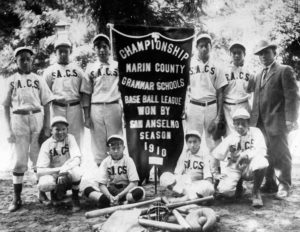
San Anselmo Grammar School Team, 1910 Champions
The San Anselmo Fire Department and the local schools also organized teams. Neighborhood teams, such as the Bush Tracts and the Ross Valley Parks, were formed anytime nine men could be pulled together. Wade Thomas, a good ball player himself, came to San Anselmo Grammar School in 1908 and encouraged both boys and girls to participate in the sport. The school won the championship of the Marin County Grammar School League in 1910.
The Early Baseball Fields
The first baseball field in town was on property owned by James Tunstead directly behind today’s town hall. Tunstead stipulated that the ball players put up a fence and refrain from loud boisterous, insulting or profane language. In 1909, George B. Hund, a local druggist and manager of the boys G.B. Hund’s, leased the ball grounds and sublet them to the “big” teams on Sunday afternoons. The following year, Tunstead donated the land to the Town as the site for the town hall, and the Marin Tocsin reported that “next year the San Anselmo baseball grounds will be no more.” In January 1911, the fence around the ball grounds was torn down and work started on the new town hall. The Tocsin again reported that the “baseball fans here are becoming uneasy because of the fact that the baseball field is no more and unless a suitable site is located within the next two months San Anselmo will be without the great national game this coming season.” Two games were played on the old field over the 4th of July weekend in 1911 after a plan was devised to protect the town hall windows from stray balls. Games were probably played on the field until construction of the San Anselmo Library began in 1914.
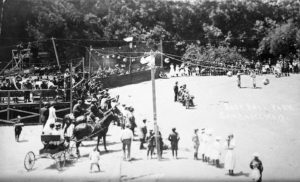
San Anselmo Ball Park, c. 1910
The Town was growing fast at this time; with the commuter train running, more and more families were moving to town. Large tracts of land were being sold to developers and subdivided for homes. The amount of open land that could accommodate a ball field. a place for town events and a playground for children was shrinking at a steady clip. Previous offers of land for a public park had been rejected by the town trustees including James Tunstead’s offer in 1911 to sell three acres adjoining the land previously donated to the town. Money was likely the major obstacle as there were so many other priorities – the town hall and fire department, the library, roads and bridges – that a town park, let alone a ballpark, was very low on the list.
By 1915, residents, town officials and the newly-formed Chamber of Commerce began to recognize the urgency in finding a site for a public recreation field, but it would be nearly a decade before that became a reality.
Sites were offered at the end of Bella Vista Avenue, on the Latham property at the foot of Red Hill, on the Short Ranch and the E.K. Wood Lumber Yard (where the Post Office is now located), but all were rejected due to financial constraints and the lack of community consensus with a 1921 bond issue failing. The hometown boys continued to play ball on fields on private land through the generosity of the owners. Once development of the town hall complex closed the ball field there, teams played on a couple of different sites on the Short Ranch, near the present-day Memorial Park, and played the 1921 season on a lot in the Osgood Tract off of Bank Street.
It was almost “curtains” for the San Anselmo team the following year as they were unable to secure a playing field in town. The pressure of development was too much. However, in July 1922, the San Anselmo Herald reported that “fans of San Anselmo and environs will no doubt be grateful to learn that in addition to a good ball team they will have a new grand stand to sit in at Kentfield for future games.” The grandstand was erected by a team of volunteers on the 26-acre athletic field at the Tamalpais Centre. The team christened the field with a 13 to 5 win over the Yosemite Markets of San Francisco.
The team continued to make improvements on the Kentfield field by adding another grandstand, showers and dressing rooms, and leveling the diamond. They ended the season with a 30-7 record!
A Town Park and Ball Field at Last
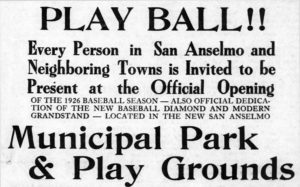 Real estate partners Thomas Kent and Thomas Minto purchased a number of unsold lots in the Short Ranch in 1924 and offered an approximately seven-acre site, suitable for a park, to the Town. The town trustees approved the purchase for $7,000 in June 1924, and development began the following year. The 1926 season opened in the new Recreation Park after public-spirited volunteers prepared the diamond and constructed the grandstand and Mercantile Trust Co. provided new uniforms for the team. The Herald reported that a “record crowd was assembled, packing the grandstand and sidelines, while a large overflow crowd in a regular flock of automobiles lined the entire field” to witness the San Anselmo boys beat the Larkspur team. The Fourth of July was celebrated at Recreation Park with “a peach of a program” that included foot races, a tug-of-war, refreshments, and of course, a baseball game, one between the San Anselmo Volunteer Fire Department and the Yolanda Oaks. “Everyone went away at the finish singing praises for the celebration and the new Recreation Park and playgrounds.”
Real estate partners Thomas Kent and Thomas Minto purchased a number of unsold lots in the Short Ranch in 1924 and offered an approximately seven-acre site, suitable for a park, to the Town. The town trustees approved the purchase for $7,000 in June 1924, and development began the following year. The 1926 season opened in the new Recreation Park after public-spirited volunteers prepared the diamond and constructed the grandstand and Mercantile Trust Co. provided new uniforms for the team. The Herald reported that a “record crowd was assembled, packing the grandstand and sidelines, while a large overflow crowd in a regular flock of automobiles lined the entire field” to witness the San Anselmo boys beat the Larkspur team. The Fourth of July was celebrated at Recreation Park with “a peach of a program” that included foot races, a tug-of-war, refreshments, and of course, a baseball game, one between the San Anselmo Volunteer Fire Department and the Yolanda Oaks. “Everyone went away at the finish singing praises for the celebration and the new Recreation Park and playgrounds.”
The San Anselmo Baseball Club joined with North Bay teams from San Rafael, Napa, Vallejo, Benicia, Petaluma, Santa Rosa and a Shriners team to form a semi-pro league in 1927. Town residents were assured of seeing the best in semi-pro baseball on Sunday afternoons in the new park.
The local amateur team, the San Anselmo Wildcats, played in a Marin County league and won the league championship in 1927 and 1928. Large crowds attended their Sunday morning games prior to the play of the semi-pro teams. The ball field at Recreation Park was in such demand by teams wanting to play there that the police and fire chiefs were put in charge of scheduling the field.
The San Anselmo Chamber of Commerce organized and sponsored the semi-pro team, the San Anselmo Merchants, in 1934. The team include former college and high school players, many of whom played with the Wildcats. The Merchants continued to field a strong team and played almost continuously until the 1960s.
Bill Franchini, a star player for both the Wildcats and Merchants, recalled: “On Sundays we played baseball. In those days, when I was just a freshman in high school, baseball was a big thing in town. I started out playing on the morning team and then as I got older I moved to the afternoon team. But that was the thing to do for people who lived in San Anselmo. They didn’t have much to do. They didn’t have cars like we do today and the population was 2,000-2,500, so on Sundays they went to the ball game over at Memorial Park. The games used to draw maybe 500 people, and we played pretty good baseball in those days.”
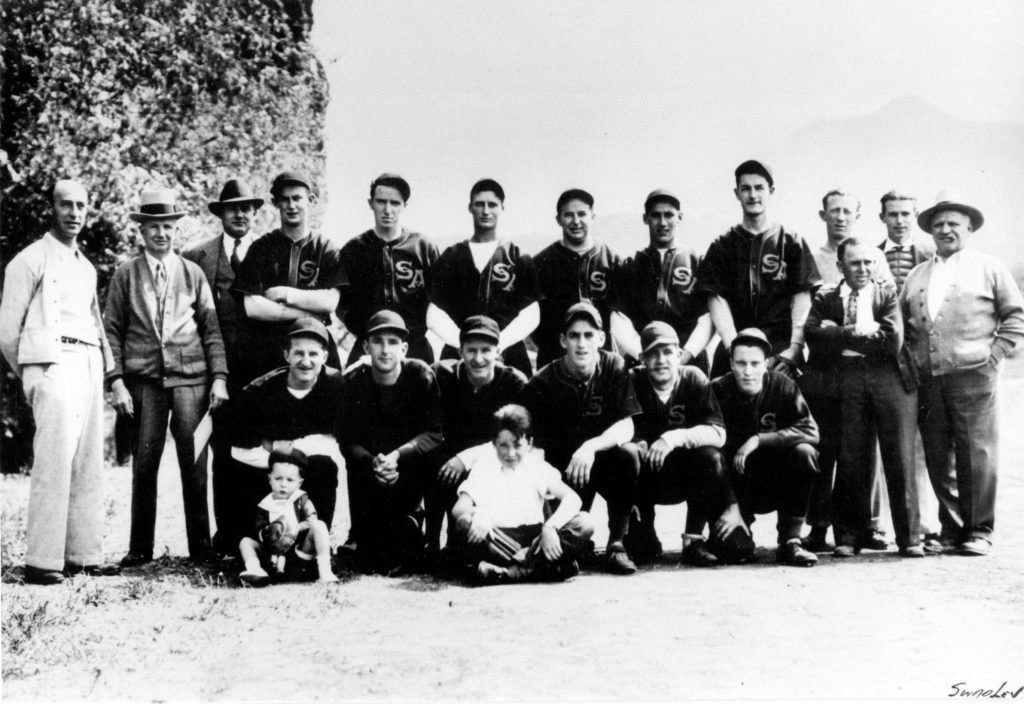
San Anselmo Merchants. 1935
Recreation Park has seen many changes and improvements since the 1930s and 1940s. It was renamed San Anselmo Memorial Recreation Park on October, 9, 1948 on the recommendation of the local Lions and Rotary Clubs and Councilman Clarence Miller. The Ongaro Plumbers, another semi-pro team, played there, Little League started and the San Anselmo Baseball Association (SABA) was formed. Generations of San Anselmo’s youths have played baseball on the diamonds or participated in other sports and recreation at Memorial Park There are 70 more years of history yet to be told! ♦
By Judy Coy and Rick Storms
2016

